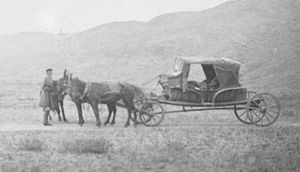Tarantass
The tarantass is a four-wheeled horse-drawn vehicle on a long longitudinal frame, reducing road jolting on long-distance travel.
The origin of the word is not known: Max Vasmer's Etymological Dictionary of the Russian Language [ru][1] lists a number of variants from regional dialects to the ancient Indo-European roots with the mark "doubtful".
Vladimir Sollogub and Alexandre Dumas gave ironic descriptions of a tarantass that may be summarized as follows.
The tarantass has been described as two long poles serving as parallel axles supporting a large basket forming a cup or bowl.
In 1893, medical doctor and Christian missionary Charles Wenyon travelled from Vladivostok to the Urals, to the marker on the boundary of Europe and Asia by a combination of tarantass and river steamer.
